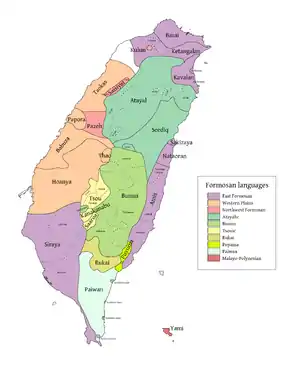虎尾壟語
虎尾壟語(Favorlang,虎尾語、費佛朗語、法佛朗語、法波蘭語、華武壟語)為台灣中部平埔族巴布薩族所用的台灣南島語言,歸類在西部平原台灣南島語族下。屬巴布薩語語族。於2011年2月21日世界母語日聯合國教科文組織發表世界各地母語現況報告。在台灣部分,其中虎尾壟語(巴布薩語)等8種語言,已被認定流失。[5][6][7][8]
| 虎尾壟語 | |
|---|---|
| Favorlang | |
| 母语国家和地区 | 台灣中部 |
| 区域 | 主要分佈於大肚溪以南至濁水溪之間的海岸地帶,涵蓋彰化平原及台中盆地西緣地區。[1] |
| 母语使用人数 | 0人(2011年)(日期不详) |
| 語系 | |
| 文字 | 拉丁字母 |
| 官方地位 | |
| 管理机构 | 台灣中央研究院 (Academia Sinica) |
| 語言代碼 | |
| ISO 639-2 | map |
| ISO 639-3 | bzg |
| 瀕危程度 | |
| 联合国教科文组织认定的濒危语言[2] (UNESCO) | |
虎尾壟語詞典與語料
台灣荷蘭統治時期1650年荷蘭籍傳教士吉爾伯特斯·哈帕特著有《虎尾壟語詞典》(Woord-boek der Favorlangsche taal)一書,1840年經英國籍傳教士麦都思翻譯成英語。另存有駐台傳教士(1647年-1651年)雅各·花德烈宣教師翻譯為虎尾壟語的主禱文、聖經片段、教义问答、及五篇講道詞等共19講語料。[9][10][11][12]
語音系統
虎尾壟語的音系之音位大都使用適當的Unicode符號來標示。在台灣南島語的書寫系統的訂定上,元輔音之音系表原則上都是先「發音部位」(橫列)、後「發音方法」(縱列)、再考量「清濁音」,來訂定其音系之音位架構。[13]
語法結構
在語法的分類上台灣南島語並不同於一般的分析語或其它综合语裡的動詞、名詞、形容詞、介詞和副詞等之基本詞類分類。比如台灣南島語裡普遍沒有副詞,而副詞的概念一般以動詞方式呈現、可稱之為「副動詞」,類之於俄语裡的副動詞。[14] 虎尾壟語語法分類是將基礎的語法之詞類、詞綴、字詞結構及分類法,對比分析語等之詞類分類法加以條析判別。[15]
虎尾壟語聖經
本主禱文來自甘為霖"臺灣宣教之成功"(Missionary Success in Formosa)一書之第八部分(XIII)裡的第4項。[16] -{
- Namoa tamau tamasea paḡa de boesum, ipa-dass-a joa naán.
- Our father, which art in Heaven, let Thy Name be praised! [17]
- Ka-ina paḡa ta Jehova oa Deosoe, tamasea pina-ijor ijo....
- I am the Lord, thy God, who led thee.... [17]
}-
-{ Namoa tamau tamasea paḡa de boesum,
ipadassa joa naán.
Ipásaija joa chachimit o ai.
Ipá-i-jorr'o oa airab maibas de boesum, masini de ta channumma.
Epé-e namo-no pia-dai torro uppo ma-atsikap.
S̩o-o abó-e namo tatáaap o kakossi namoa,
maibas channumma namo mabo tamasea parapies i namo.
Hai pásabas i namo, s̩o-o barras'i namo innai rapies ai.
Inau joa micho chachimit o ai, s̩o-o barr'o ai, so-o adas ai, taulaulan,
Amen.}-
註釋
- "巴布薩族地理分布",2011/07.
- UNESCO Atlas of the World's Languages in danger, UNESCO
- Blust, R. (1999). "Subgrouping, circularity and extinction: some issues in Austronesian comparative linguistics" in E. Zeitoun & P.J.K Li (Ed.) Selected papers from the Eighth International Conference on Austronesian Linguistics (pp. 31-94). Taipei: Academia Sinica.
- Paul Jen-kuei Li," Some Remarks on the DNA Study on Austronesian Origins",Languages and Linguistics 2.1:237-239,2001.(英文)
- "UNESCO’s list of endangered languages",Thinking About Languages, April 25, 2011 .
- "UNESCO Atlas of the World's Languages in danger",2011.
- 黃美金,"臺灣南島語言學研究的回顧與展望",BIBLID 0254-4466(2000)18:特刊,pp.79-110/漢學研究第18卷特刊(民國89年12月).
- 陳欽育/國立故宮博物院專門委員/大同大學通識教育中心兼任副教授,"荷據時代華武壠社消失的原因--以遷徙為中心" 页面存档备份,存于,2011年查閱.
- Dictionary: Dictionary of the Favorlang dialect of the Formosan language, by Gilbertus Happart (1650), translated from Dutch to English by W. H. Medhurst (1840).
- 吳國聖,"17 世紀臺灣Forvorlang 語字典(Woord-boek der Favorlangsche taal):編纂過程初探",國立政治大學民族學系,2011查閱.
- 郭弘斌,"荷蘭語在台灣的推行-台灣人的歷史",台灣海外網,2011年查閱.
- 施忠賢,"荷蘭語言政策與原住民識字能力的引進(1624-1662)",施忠賢的家 - Home of Justin Shih - Justin,2011內查閱.
- 行政院原住民族委員會,"原住民族語言書寫系統" 页面存档备份,存于,台語字第0940163297號,原民教字第09400355912號公告,中華民國94年12月15日.
- 張永利,"台灣南島語言語法:語言類型與理論的啟示(Kavalan)" 页面存档备份,存于,語言學門熱門前瞻研究,2010年12月/12卷1期,pp.112-127.
- Barbara B.H. Partee, A.G. ter Meulen, R. Wall,"Mathematical Methods in Linguistics (Studies in Linguistics and Philosophy)(語言研究的數學方法)" 页面存档备份,存于,Springer,1/e 1993 edition(April 30, 1990).
- Rev. WM. Campell/F.R.G.S. English Presbyterian Mission Taiwan For,"Aa Account Of Missionary Success In The Island Of Fformosa",London Trubner & Co.,57 Ludgate Hill 1889,pp.203-214.
- (Li 2003:8), Li, Paul Jen-kuei. 2003. "Introduction: Notes on Favorlang, an Extinct Formosan language." In Ogawa, Naoyoshi. 2003. English-Favorlan g vocabulary, pp. 1–13. Tokyo: Research Institute for Languages and Cultures of Asia and Africa. ISBN 9784872978537
參考文獻
- Happart, Gilbertus, Walter Henry Medhurst (trans.). 1840. Dictionary of the Favorlang dialect of the Formosan language, written in 1650. Batavia, Printed at Parapattan. ISBN 1142264017, ISBN 978-1142264017 (Publisher: Nabu Press (January 12, 2010), Paperback: 396 pages)
- Li, Paul Jen-kuei. 2003. "Introduction: Notes on Favorlang, an Extinct Formosan language." In Ogawa, Naoyoshi. 2003. English-Favorlang vocabulary, pp. 1–13. Tokyo: Research Institute for Languages and Cultures of Asia and Africa. ISBN 4872978536, ISBN 9784872978537
外部連結
- 巴布薩語ISO 639-3代碼
- 法波蘭--臺灣原住民歷史語言文化大辭典
- 追尋華武壟:以荷蘭文獻重構華武壟(Favorlang)民族誌
- Dictionary: Dictionary of the Favorlang dialect of the Formosan language, by Gilbertus Happart (1650), translated from Dutch to English by W. H. Medhurst (1840).

